“Painting a mural is a lot like trying to follow Christ.”
A note from the Muralist
It is finished! Although my heart is relieved and I can now rest in the satisfaction of the mural’s completion, I cannot imagine this sense of accomplishment draws near to that which Jesus felt upon the cross. I hope that upon its unveiling, it will draw your heart to consider the greatness of Him who suffered with so much love for us. This note is not intended to explain the meaning of the mural; at the request of the parish, that will come later. Instead, this article will expound upon the conception and rendering of the mural.
Click here to watch a video of Rain Escovedo’s painting efforts, Music from Cirque du Soleil
It began long ago in the heart of a devout parishioner with an appreciation for all things good, true, and beautiful. When our new pastor Fr. Mowery showed an interest in improving the aesthetics of our church; she asked him if it would be possible to have someone paint a mural on the blank dusty wall behind the statue of our patron, Saint Columba. Somewhat aware of the artistic capacities God bestowed upon me, Fr. Mowery asked if I would be willing to paint the mural. After a little thought and prayer, I received this as an answer from God to the silent longings of my heart to glorify Him in some way with the gift he had given me. There was hesitation in saying yes however, because I am not a trained artist. To be honest, it was a foolish thing to say yes to a project I had minimal experience in; but God can do great things with very little. For weeks I could not think of what to paint. Until one night after venting my frustration to God I went to bed and He gave it to me in a dream. Awaking in the middle of night, I fervently sketched out a horribly rough depiction of what I saw. What is painted now does not even come close to its beauty.
When I presented it to Fr. Mowery, I suspect he thought it was a bit much, because he asked me to complete another idea so the parish could vote on what they wanted. The next couple of weeks I scoured the internet and art books for ideas, absorbing image after image. I read scriptures and tried to visualize in my mind their descriptions. I knew if I tried to sketch this entire piece on my own it would never get done in the time I was allotted. So, I traced portions of several references and altered them to form a composite that was satisfactory. The two options were displayed for the parishioners to vote on and to my shock and dismay and you chose the vision from my dream. I prayed to seek God’s consolation. He reminded me that if He had asked me to do this, He would provide the grace. The next couple of months I spent days researching the proper materials, methods, refining a color palette and begging for God’s providence.
Then the scaffold was erected, and a dear friend and fellow parishioner CJ Perez helped me project the sketch onto the wall to trace the faint outline. Once the paint and supplies were purchased, I would spend almost every Monday, Tuesday, and Friday night after work in the church with Jesus trying to portray what he showed me that night months before. At the start of each session I would come before Jesus in prayer to remind myself Who I was doing this for, and to offer it back to Him. If it was not for that time in prayer, this project would never have been completed. Each passing day I felt time was slipping through my hands. I would think I was finished with a portion only to come back another day and hate it so I would change it. Many nights I would literally cry out to God in frustration wanting to quit, but begging His help instead, admitting I couldn’t do it on my own. Like the Good Father He Is, He would come with grace to aid me and I would stand humbled and baffled at how what was impossible for me alone suddenly became possible. Soon, He started teaching me to pray as I painted which prevented mistakes and additional help came in the form of another dear friend, Lucas Southerton, who helped lay down crucial base layers of paint on the lower portion of the wall. In the final stretches of the mural’s creation I began coming in Saturdays to paint also until finally, one day it was the last stroke of the brush. I packed up my things, thanked God, and went home.
Painting a mural is a lot like trying to follow Christ. He invites us. We say yes. Often we foolishly think we can do it quickly, excellently, and without help. He humbles us. He helps us. He uses us, in our inadequacy, to do something beautiful. In the end, He is the one to be thanked, then we go home.
~PAX, Rain Escovedo
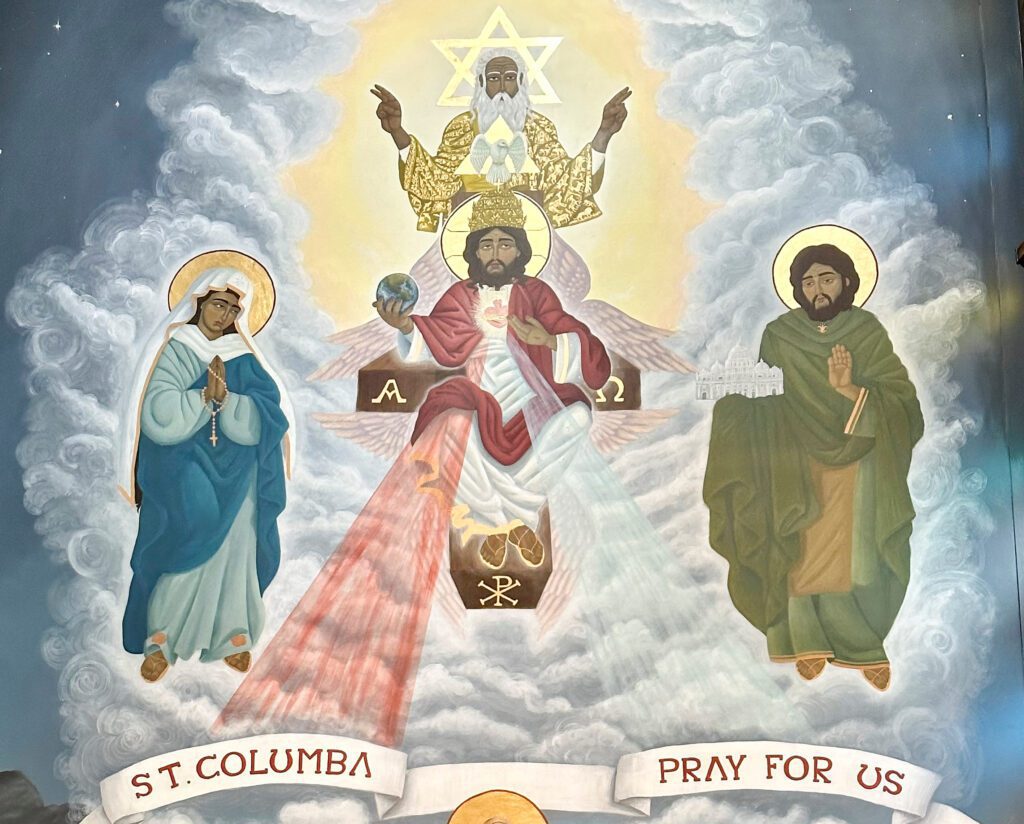
In this detailed photo, you can see the Immaculate Virgin Mary standing to the right of Jesus, clothed in her signature blue mantle and robes that symbolize her royalty. Her gold-trimmed white veil and shawl are signs of her perfect purity and virtue. In biblical times a woman’s hair was her glory, and she is the most glorious of all women, so her thick black tresses extend to her knees. Her magnificent beauty, a reflection of God’s, is too holy not to veil and cover in reverence. She gazes upon her Son, with hands positioned in prayer, interceding for all the petitions that come through the rosary that encircles them. The crucifix dangles at the height of her womb, reminding us that she is the one who bore our Savior. Upon her feet are two golden roses, hearkening back to the apparition of our Lady of Lourdes. They symbolize her humility in obediently following the will of God, leading her to share the Divine Triumph.
Saint Joseph stands to the left of Jesus holding St. Peter’s Basilica, the icon of the Roman Catholic Church. In 1870 the Pope declared St. Joseph the Patron of the Universal Church. Here we see him reverently holding her foundations, as he once cradled Christ. His understanding of her sacredness is shown in how his hand is covered in his mantle as a priest might hold a monstrance containing Christ during the benediction. After all, the Church is the body of Christ. Saint Joseph’s other hand is raised and open, this gesture symbolizes righteousness as well as prayer and the reception of graces. His downcast gaze depicts his humility and yet it is fixed upon the church portraying his vigilance and intent in caring for her. At his collar is a golden lily with three stamens symbolic of his divinely granted purity of mind, body, and soul. The green of his mantle represents how he remained balanced and calm, trusting in the word of God to preserve the life and freedom of the Holy Family through great trials. Beneath his mantle, St. Joseph still wears his leather laborer’s apron, showing that even in heaven, he remains willing to do whatever work God asks of him.
In this photo is Muralist Rain Escovedo.
On behalf of St. Columba parish, thank you Rain, and also special thanks to Ed Dilg for cleaning and preparing the wall, sealing the artwork, and mounting our St. Columba statue. Thank you also to Larry Snyder and the Tuesday Crew, for their continued assistance in all church projects, and notably, our new St. Columba prayer box.
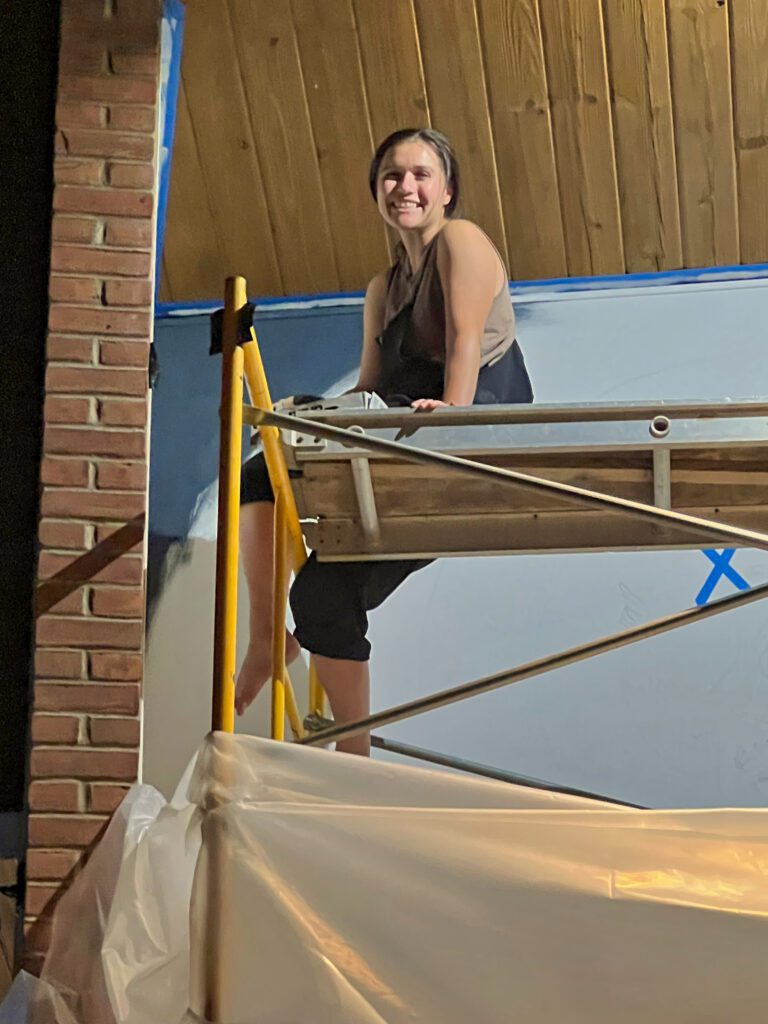
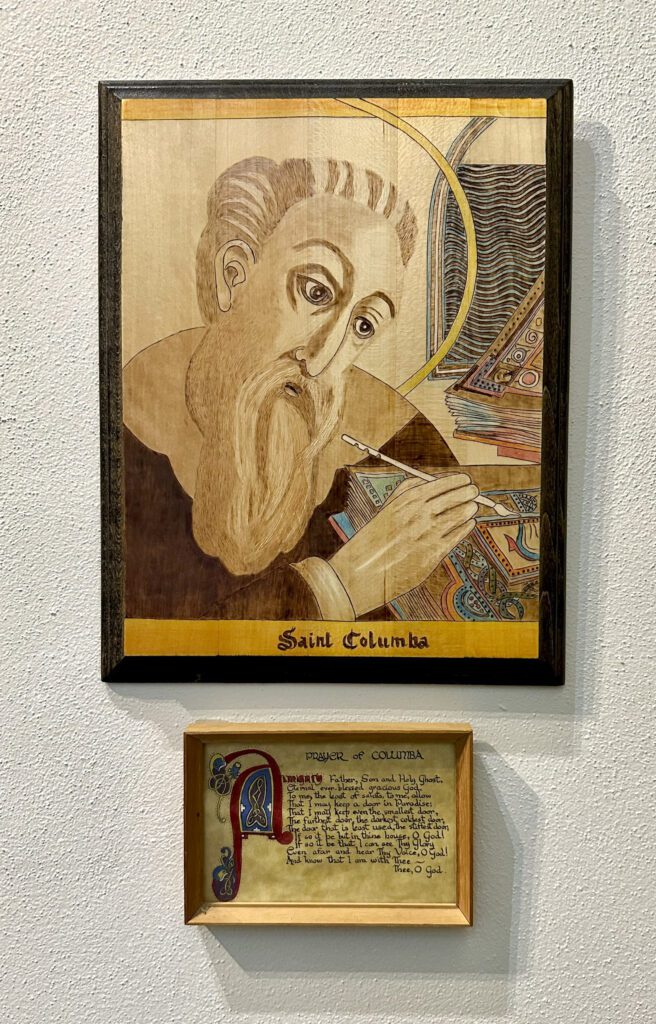
Thank you for Dennis Hardt for creating and donating an intricate and beautiful woodcarving of St. Columba, mounted on the white wall to the left of the mural, representing St. Columba working on a manuscript (his Monastery on the island of Iona is where the Book of Kells, an illuminated manuscript of the Gospels, was created).
Before every painting session, Rain took time to pray that God would inspire her and guide her hand as she worked. Says Rain, “I am grateful to Him to have been able to be His little instrument.”
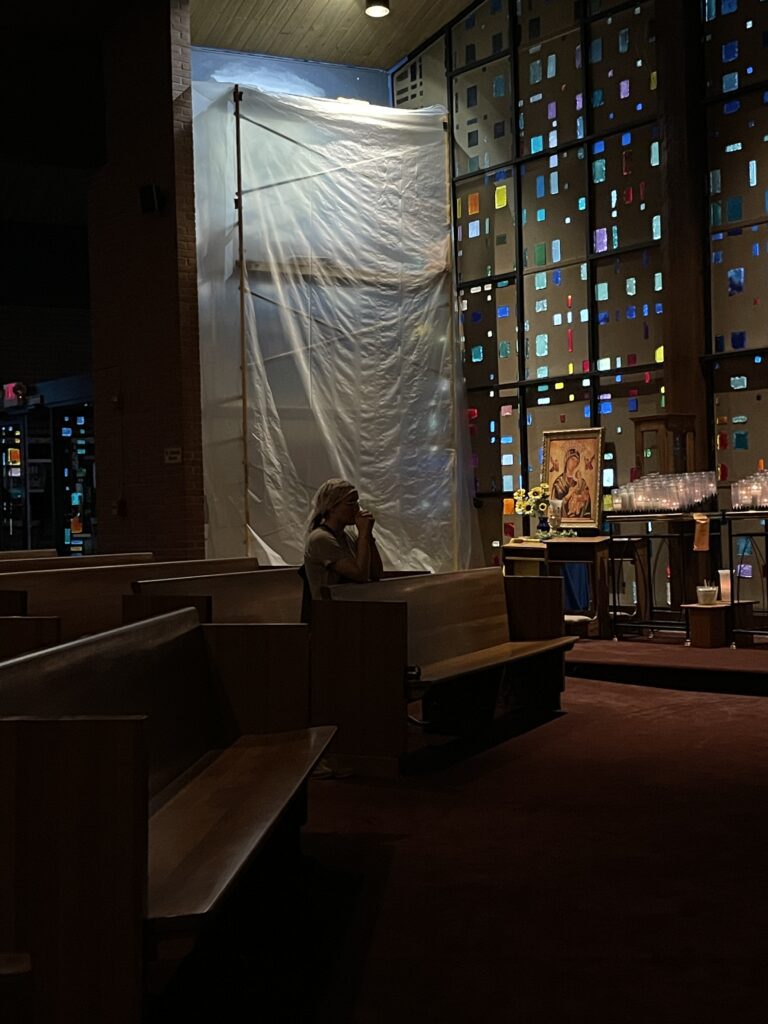
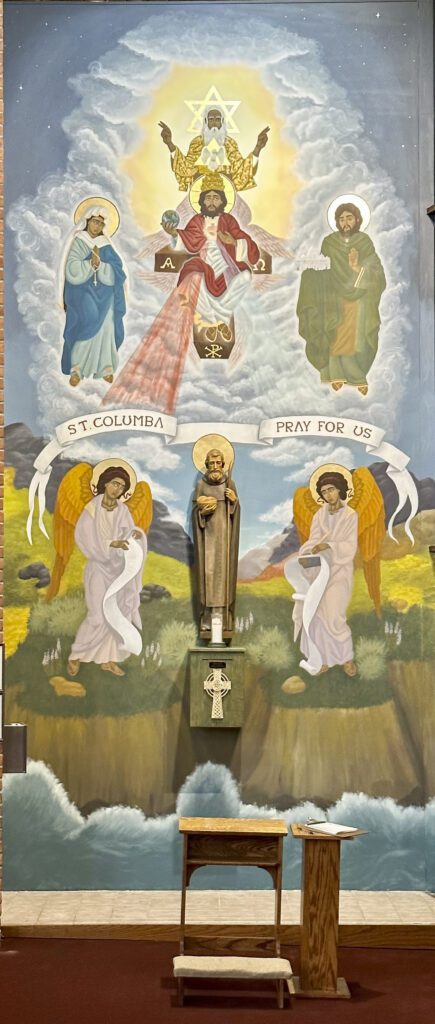
This mural is a type of icon. Though not quite Orthodox, it is still intended to be a “window into heaven” not to be looked at, but looked through. It’s strange details and the disproportionate figures are intentional. These features are supposed to make the viewer contemplate why they were depicted this way and what they mean.
The Holy Trinity is depicted wreathed in smoke amid the glory cloud coming forth from a bright portal from heaven, flanked by the Virgin Mary and Saint Joseph above two angels and Saint Columba. The Heavenly Father raises His hands in a gesture of benediction, blessing creation with His revelation. His locks and beard are long and white, symbolizing His eternal existence and wisdom. The relative youthfulness of His face brings to mind that He is immutable. The robes of gold that drape His figure are embroidered with glowing depictions of all living things, most near to His heart the human family to illustrate that he is the God of Life. His halo is shaped like the Star of David as a reminder that our Christian faith is a fulfillment of the Jewish prophets and law. Our God Is the God of Abraham, Isaac, and Jacob. He is the God of David, and Jesus Christ is the Son of David, the promised King whose reign would be everlasting. That is why Jesus is portrayed as a king seated on His throne. His throne is the cross upheld by the sunrise-shaded wings of the cherubim. In it are inlaid golden symbols of His identity: The Alpha and Omega signify the beginning and the end of all things; the Chi Rho represents the Christos. The world gently rests in His palm, and His Sacred Heart, which he beckons us to recognize, emanates the rays of Divine Mercy. These remind us of his tender care and
providence for humanity. Atop Jesus’s head is an elaborate Papal Triple Tiara, symbolizing His sacred orders as eternal high priest and sovereign judge. He is the one who has reign over the universe as sole spiritual and moral authority. His rule supersedes all civic and secular leaders. The Papal Triple Tiara was once abandoned as a gesture of renouncing human glory for love of the poor, but in the life to come, poverty ceases to exist, and humanity is glorified in purity without corruption and scarcity. His Halo reflects the same identity with the Orthodox red cross, red alpha line and white omega line. Between Jesus and the Father humbly and peacefully hovers the Holy Spirit in His triangle halo, representing the Unity of the Trinity.
In this picture Rain made two drawings of a potential mural for the wall behind our statue of St. Columba. This is the original option A that was chosen by parishioners through their votes.
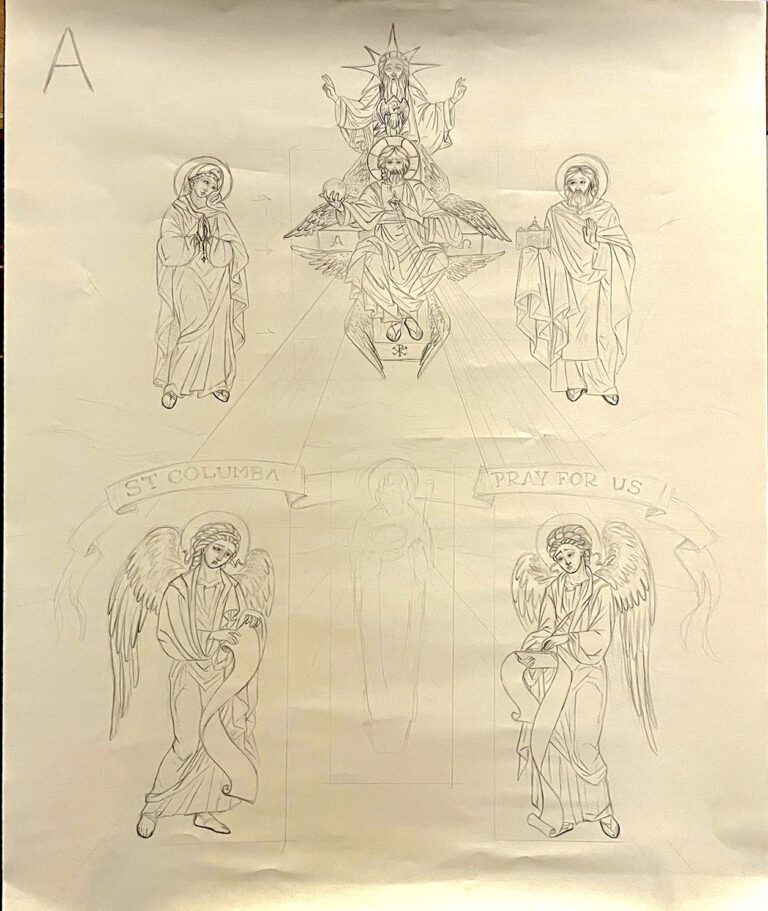
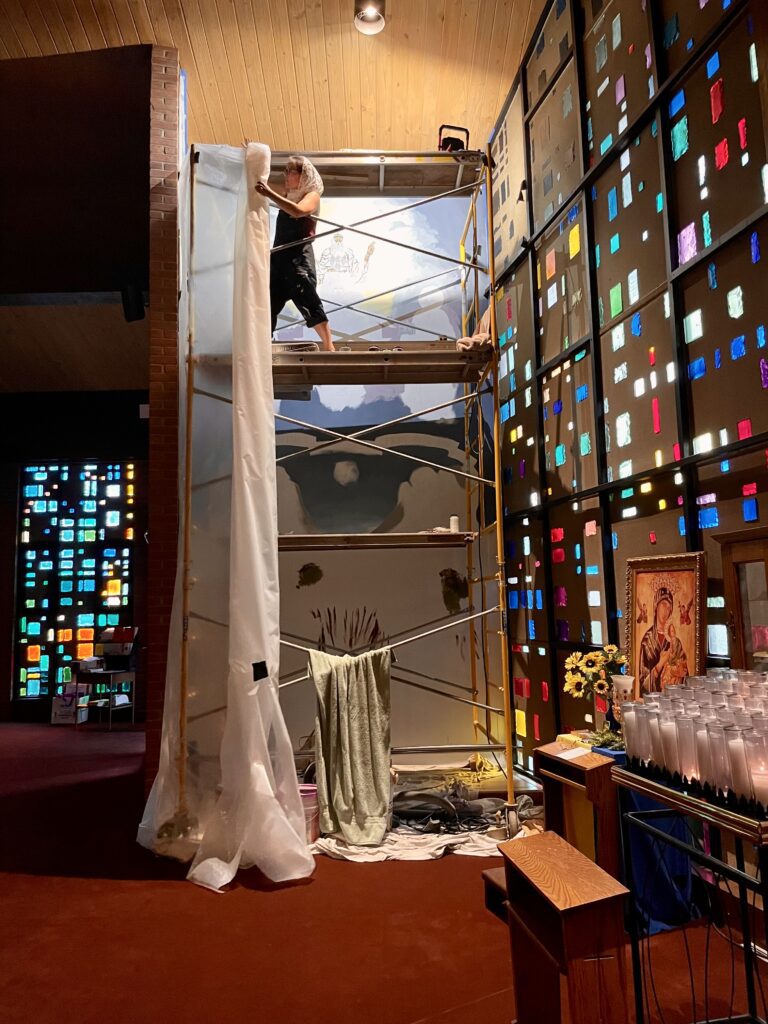
After scaffolding was erected and the original sketch was transferred to the wall, a plastic sheet was attached to the top railing. To begin each painting session, Rain first had to climb to the top section and push back the plastic. Rain worked most of the time with one overhead light and a second, portable light that illuminated the area she was painting.
In this detailed image of the bottom half of the mural, the two angels are robed in rose and violet, suggesting the Advent season of waiting for Christ’s coming. They remind us to remain ever watchful for the blessed hour of His return, with repentance for our sins and rejoicing in His greatness. Beneath the red ray which symbolizes Christ’s blood, the life of our souls, the angel is rolling up his scroll. On it are the invisible yearnings of every heart for a share in God’s eternal life. The scroll is being rolled up because at Christ’s return that life will be given and the yearning will cease with ultimate satisfaction. The decision will be final for those who choose Christ and those who deny Him. Beneath the pale ray, symbolic of the water that poured from Christ’s heart upon the cross, which is what cleanses us and makes us righteous, there stands another angel. This angel is still writing all the praises and blessings overflowing from the grateful hearts of the faithful. This angel is still writing, because on the day of Christ’s return all the devout will lift their heads and rejoice gushing unutterable worship.
Saint Columba and the angels stand at a cliff’s edge. They are already in the new earth beyond the great chasm. The raging sea at the bottom of the mural symbolizes that uncrossable void between heaven and hell. Between a life without God and eternity with Him. The viewer stands in the Church, ours in particular convenient for the metaphors with its ark-like architecture. The Church is the ship that takes us across that sea of chaos by Divine Grace. Soon our pilgrimage will be over, and our feet will touch that grassy plain of the new creation. Just as the hills rejoice blossoming with flowers, so will our bodies be glorified in God’s presence, more beautiful than ever.
The background reminds us that God is creator of all that is. The vast mysterious universe we glimpse at night and all its celestial bodies are formed, known, and named by Him. The tempest and clouds with all their uncontrollable power are guided by His hand. Each new day, which we so often take for granted, is brought forth by His generous blessing. The highest mountains, lowest valleys, vastest plains, and sheerest cliffs are all his artwork. As reflected in our Catechism (#257), God is “eternal blessedness, undying life, unfading light. God is love: Father, Son and Holy Spirit” He Is The One Who Is.
Photography by Sam Bidleman
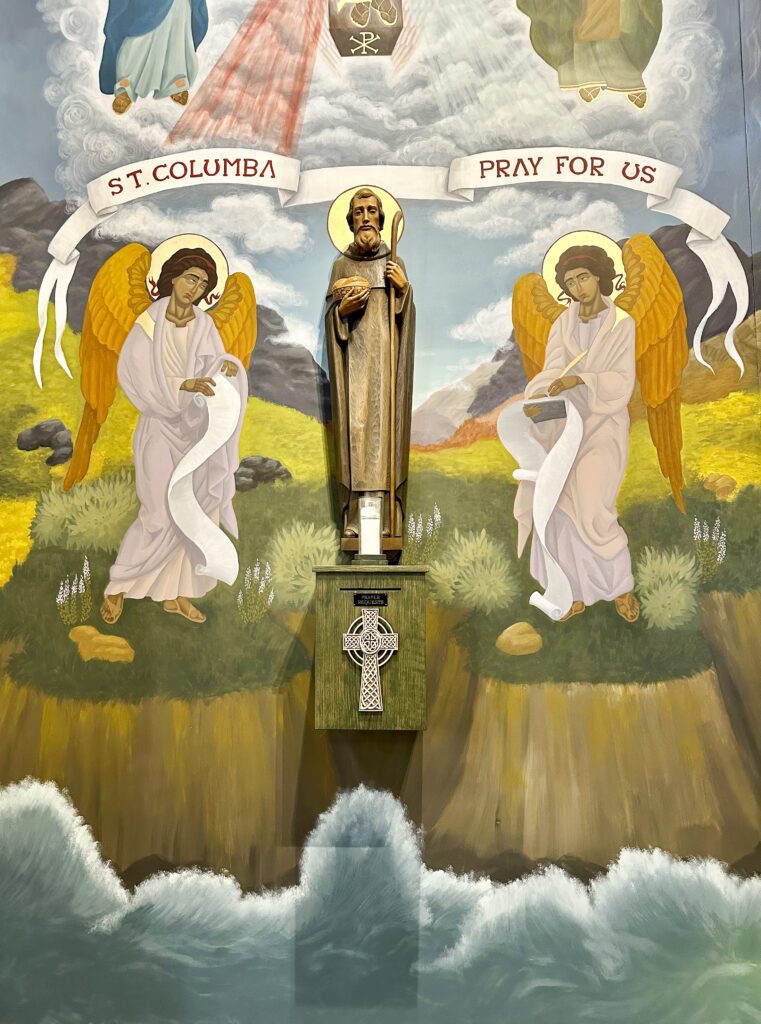
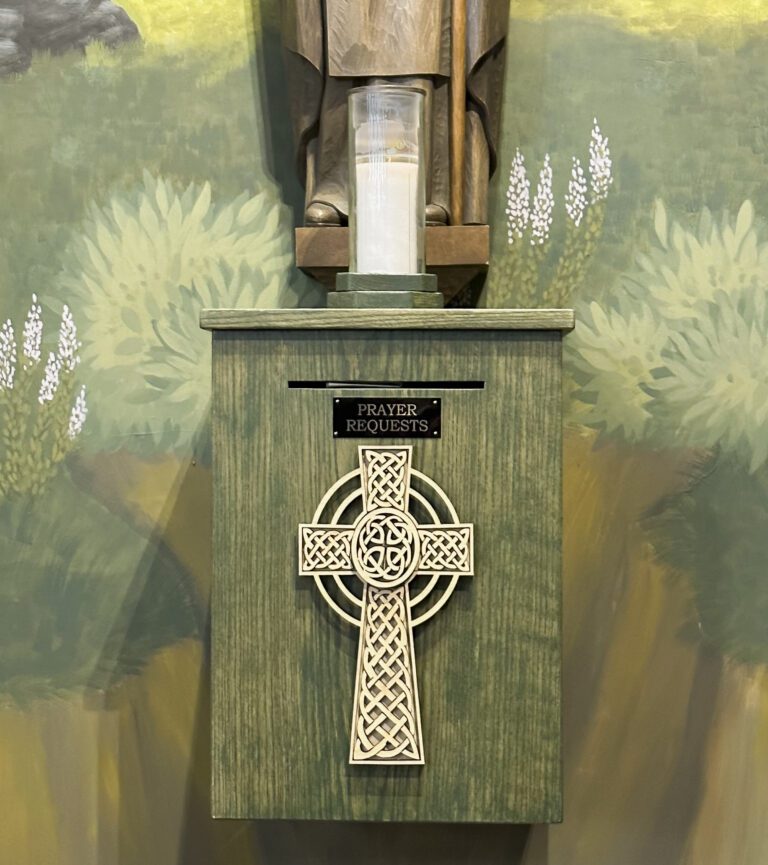
A Prayer Requests box, crafted by Tuesday Crew’s founding member Larry Snyder, is mounted just below the statue of St. Columba. A kneeler and stand with paper and pen are located in the same area. You are invited to write your requests and insert them into the slot on the front top of the box. A candle will remain lit during the week. At the Easter Vigil, all requests will be incorporated into the Easter fire.
Prayer requests can also be made online.


